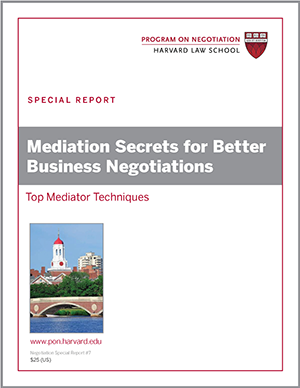
More and more companies are inserting alternative dispute resolution (ADR) clauses in their contracts with customers and vendors—and even, in some cases, in agreements with their own employees. ADR clauses can be beneficial for all concerned if it means avoiding the cost, delay, and uncertainty of going to court. Mandated mediation, in particular, may offer more creative solutions, protection of confidentiality, and preservation of important relationships as compared to litigation.
A judge may also require parties to a civil dispute to engage in mandated mediation. Such mandated mediation, or court-ordered mediation, can save disputants and the courts time and money by giving parties a chance to resolve their conflict quickly and efficiently. But mandated mediation tends to have a much lower success rate than voluntary mediation because parties may be reluctant participants in the process, which generally requires a collaborative and creative mindset to succeed.
This article describes the basics of mediation and presents the mediation strategies and techniques that you can expect from a mandated mediation process.
What is Mediation in Conflict Resolution?
In mediation, a neutral third party tries to help parties to a conflict negotiate a resolution that is sustainable, nonbinding, and satisfactory to both sides. Professional mediators can be called on to lead the mediation process, which involves helping parties work together to come up with creative proposals aimed at resolving their differences.
Mediation has a number of benefits as a dispute-resolution process. To begin with, mediation strategies prompt disputants to be proactive about finding a solution to their shared problem. By brainstorming and collaborating, parties in conflict often strengthen their relationship during mediation and are better equipped to work together in the future.
Mediation is also a relatively fast, inexpensive, and less formal means of resolving disputes as compared to other forms of ADR, including arbitration and litigation. And as compared to those other ADR processes, mediation gives disputants greater control over the outcome of the process. Parties to a mediation are free to reject proposals that they feel do not meet their interests, though doing so could require them to engage in civil litigation.
Disputants may also value the privacy offered by mediation. As compared to the more public setting of a courtroom or hearing room, mediation is typically conducted in private offices or meeting rooms.
Typically, mediation is a voluntary process. As such, some view mandated mediation as contrary to the basic tenets of mediation. Yet mandated mediation may have the benefit of getting reluctant disputants to participate in the process, with potentially positive results.
6 Stages of Mediation
In her chapter, “Mediation,” in The Handbook of Dispute Resolution (Jossey-Bass, 2005), professional mediator Kimberlee K. Kovach describes the most common mediation steps:
- Before mediation begins, the mediator helps the parties decide where they should meet and who should be present.
- Mediator’s introduction. With the parties gathered together in the same room, the mediator introduces the participants, outlines the mediation process, and lays out ground rules.
- Opening remarks. Each side then has the opportunity to present its view of the dispute without interruption. In addition to describing the issues they believe are at stake, they may also take time to vent their feelings.
- Joint discussion. The mediator and the disputants are free to ask questions aimed at reaching a better understanding of each party’s needs and concerns. Because disputing sides often have difficulty listening to each other, mediators repeat back what they have heard and ask for clarification when necessary.
- The mediator might split the two sides into separate rooms for private meetings—also known as caucuses—which are typically confidential. The promise of confidentiality can encourage disputants to share new information about their interests and concerns, which the mediator can then propose without revealing that it came from the other party. This process can keep negotiators from devaluing each other’s proposals just because they don’t like or trust the other party.
- The disputants practice effective negotiation techniques to formulate ideas and proposals that meet each party’s core interests. Some resolutions reached in a negotiation will truly be “win-win”; others will be just barely acceptable to one or both sides. If the parties come to consensus, the mediator will outline the deal terms and may write up a draft agreement.
Have you ever engaged in mandated mediation, and if so, did you find the process to be helpful?





